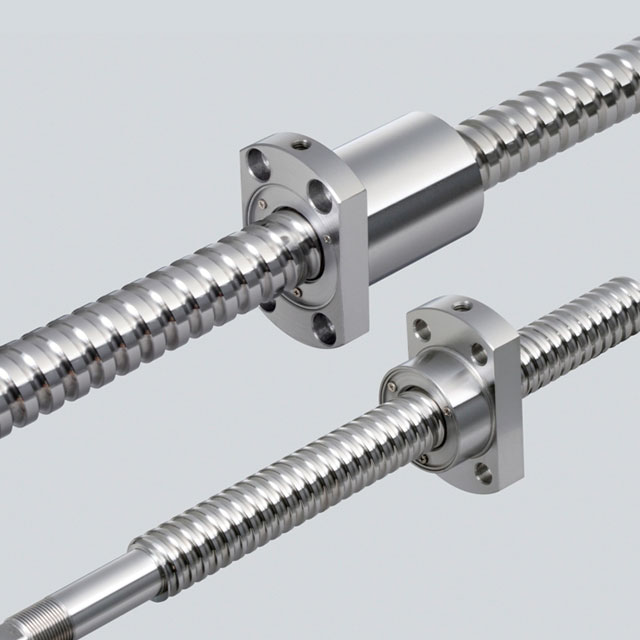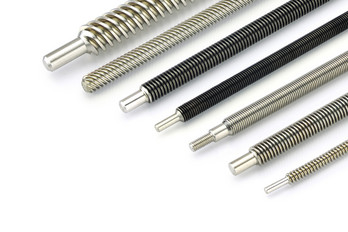Product Description
Lead Screw Thread brass nut stainless steel Reciprocating screw
Product Description
1. Cold rolled ball screw;
2. Gcr15 material;
3. High-speed operation
4. C5 C7 C10 precision;
5. No gap and preloading
6. Quality as good as TBI brand is high precision, long life use.
7. Pay more attention to before-sale, in-sale, after -sales service.
8. Manufacturer with large stock & short delivery
1.We can offer OEM ODM SERVICE accoding your drawing.
2.we can accoding u drawing do the ball screw end
3. We can design custom ball screw,according to customer’s requirement
4.We can supply the ball screw auxiliary product ,servo motor, ball screw support nuit, nut housing, coupling and so on
Product Parameters
| Reciprocating screw specifications | |||
| Diameter(mm) | Lead(mm)/pitch | Effective stoke(mm) | Total length(mm) |
| 10 | 10 | 50 | 130 |
| 10 | 10 | 80 | 200 |
| 10 | 10 | 100 | 200 |
| 10 | 10 | 120 | 150 |
| 10 | 10 | 150 | 250 |
| 10 | 10 | 200 | 300 |
| 20 | 20 | 150 | 400 |
| 20 | 20 | 200 | 430 |
| 20 | 20 | 220 | 430 |
| 20 | 20 | 250 | 460 |
| 25 | 25 | 300 | 460 |
| 25 | 25 | 350 | 600 |
| 25 | 25 | 400 | 600 |
| 25 | 25 | 500 | 700 |
| Can be customized | |||
Detailed Photos
Factory Tour
Certifications
Company Profile
Contact us
| Material: | Carbon Steel |
|---|---|
| Axis Shape: | Straight Shaft |
| Shaft Shape: | Stepped Shaft |
| Appearance Shape: | Round |
| Transport Package: | Wooden Case |
| Specification: | can be customized |
| Customization: |
Available
|
|
|---|

Can lead screws be customized for specific industries or machinery configurations?
Yes, lead screws can be customized to meet the specific requirements of different industries or machinery configurations. Customization allows for the adaptation of lead screws to unique applications, ensuring optimal performance and compatibility. Here’s how lead screws can be customized:
Thread Design:
The thread design of lead screws can be customized to suit specific applications. The thread profile, such as Acme, square, or buttress, can be selected based on factors such as load capacity, efficiency, backlash, and self-locking characteristics. The thread pitch can be adjusted to achieve the desired linear travel per revolution, allowing for different positioning resolutions. Custom thread designs can also be implemented to address specific requirements or constraints of the machinery configuration.
Materials and Coatings:
The choice of materials for lead screws can be customized based on the application’s environmental conditions and performance requirements. Different materials, such as stainless steel, carbon steel, or alloys, can be selected for their mechanical properties, corrosion resistance, or temperature resistance. Additionally, lead screws can be coated or treated with specialized coatings, such as Teflon or ceramic coatings, to reduce friction, improve wear resistance, or enhance lubrication properties.
Size and Dimensions:
The size and dimensions of lead screws can be customized to fit specific machinery configurations or space constraints. This includes variations in length, diameter, and thread length to ensure proper fit and integration within the machinery or system. Customization of lead screw dimensions allows for efficient utilization of available space and compatibility with existing components or mounting mechanisms.
End Machining:
Lead screws can be customized with different types of end machining to facilitate their connection to other components or power sources. This may involve the addition of keyways, flats, or other features to enable coupling with drive mechanisms, such as motors or handwheels. Customized end machining ensures proper alignment, torque transmission, and ease of installation within the specific machinery configuration.
Accessories and Attachments:
Customization of lead screws can also involve the addition of accessories or attachments to enhance their functionality or compatibility with specific industries or machinery configurations. This may include the inclusion of anti-backlash nuts, thrust bearings, lubrication systems, or wipers. These accessories and attachments can improve precision, reduce wear, increase load capacity, or address specific application requirements.
By offering customization options, lead screw manufacturers can cater to the diverse needs of different industries and machinery configurations. Customized lead screws ensure that the linear motion system is optimized for performance, efficiency, and compatibility, resulting in improved overall functionality and reliability.

How do electronic or computer-controlled components integrate with lead screws in modern applications?
In modern applications, electronic or computer-controlled components play a crucial role in integrating with lead screws to enhance functionality, precision, and automation. These components enable advanced control, monitoring, and feedback capabilities, allowing for more efficient and accurate operation of systems incorporating lead screws. Here are some ways electronic or computer-controlled components integrate with lead screws in modern applications:
- Position Control: Electronic control systems can precisely control the position of the lead screw by monitoring and adjusting the rotational movement of the motor driving the screw. Position feedback sensors, such as encoders or linear scales, provide real-time information about the screw’s position, allowing the control system to accurately position the load. This integration enables precise positioning and highly repeatable motion control in applications such as CNC machinery, 3D printers, or robotic systems.
- Speed and Velocity Control: Electronic control systems can regulate the speed and velocity of the lead screw by controlling the motor’s rotational speed. By adjusting the motor speed, the control system can achieve specific linear speeds or velocity profiles along the length of the lead screw. This integration is particularly useful in applications where controlled acceleration, deceleration, or dynamic speed changes are required, such as automated manufacturing processes or motion control systems.
- Force and Torque Control: In some applications, it is necessary to control the force or torque applied by the lead screw. Electronic control systems can monitor and adjust the motor’s current or voltage to regulate the applied force or torque. This integration allows for precise force control, load balancing, or torque limiting in applications such as material testing machines, automated assembly systems, or lifting mechanisms.
- Automation and Synchronization: Electronic or computer-controlled components facilitate the automation and synchronization of multiple lead screws or other mechanical components. Through centralized control, these components can coordinate the movements of multiple lead screws, ensuring precise and synchronized motion. This integration is commonly used in complex systems with multiple axes of motion, such as multi-axis CNC machines or robotic systems.
- Monitoring and Diagnostics: Electronic control systems can monitor the operating parameters of lead screws, such as temperature, vibration, or load conditions. By integrating sensors and monitoring algorithms, the control system can detect abnormal conditions, provide real-time feedback, and trigger appropriate actions, such as alerting maintenance personnel or implementing protective measures. This integration enhances system reliability, prevents failures, and enables predictive maintenance in applications where lead screw performance is critical.
- Human-Machine Interface (HMI): Electronic or computer-controlled components often provide a user interface through which operators can interact with the lead screw system. HMIs allow operators to input commands, monitor system status, and receive feedback. This integration simplifies system operation, enables parameter adjustments, and facilitates troubleshooting or diagnostics.
In summary, electronic or computer-controlled components play a vital role in integrating with lead screws in modern applications. Position control, speed and velocity control, force and torque control, automation and synchronization, monitoring and diagnostics, and human-machine interface capabilities enhance the functionality, precision, and automation of systems incorporating lead screws. This integration enables advanced control, improved performance, and enhanced operational capabilities in various industries and applications.

In what industries or applications are lead screws commonly utilized?
Lead screws are commonly utilized in various industries and applications that require precise linear motion, positioning, or adjustment of components. Here are some of the industries and applications where lead screws are frequently used:
- CNC Machining: Lead screws play a vital role in computer numerical control (CNC) machines. They are used in the linear motion systems of CNC mills, lathes, and routers to position and move the cutting tools or workpieces with high accuracy and repeatability.
- 3D Printing: Lead screws are widely employed in 3D printers to control the movement of the print head or build platform. They enable precise positioning of the print head, ensuring accurate layer-by-layer deposition of the printing material.
- Robotics: Lead screws find extensive use in robotic systems for various applications. They are utilized in robotic arms to control the movement and positioning of the end effectors or grippers. Lead screws also enable precise linear motion in robot joints, allowing for accurate and controlled robotic movements.
- Medical Equipment: Lead screws are employed in medical equipment and devices that require precise linear motion control. They can be found in medical imaging systems, laboratory automation equipment, surgical robots, patient positioning systems, and other medical devices.
- Industrial Automation: Lead screws are utilized in industrial automation applications for precise positioning and linear motion control. They are commonly found in assembly lines, packaging machines, material handling systems, and automated testing equipment.
- Aerospace and Aviation: Lead screws find use in aerospace and aviation applications that require accurate control of movable components. They can be found in aircraft controls, navigation systems, satellite positioning mechanisms, and aerospace testing equipment.
- Optics and Photonics: Lead screws are utilized in optics and photonics applications that require precise positioning or adjustment of optical components. They can be found in telescopes, microscopes, laser systems, and optical testing equipment.
- Industrial Machinery: Lead screws are commonly used in various types of industrial machinery. They can be found in equipment such as milling machines, drilling machines, grinding machines, textile machinery, printing presses, and many other types of machinery that require controlled linear motion.
- Automation in Home and Office: Lead screws are also utilized in automation systems for home and office applications. They can be found in motorized adjustable desks, automated window blinds, camera sliders, home theater systems, and other automated systems that require precise linear motion control.
These are just a few examples of the industries and applications where lead screws are commonly utilized. The versatility, precision, and reliability of lead screws make them a valuable component in numerous mechanical systems that require controlled linear motion or positioning of components.


editor by CX 2023-12-04